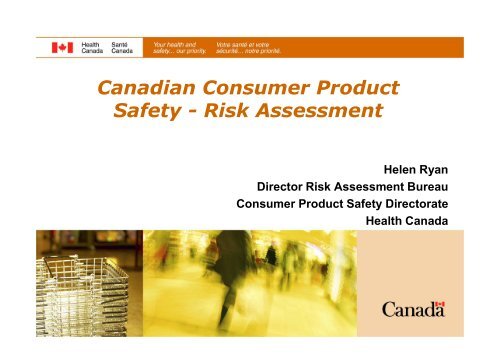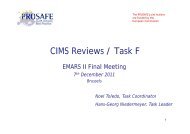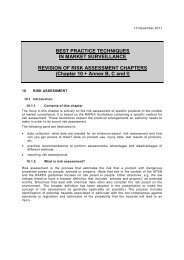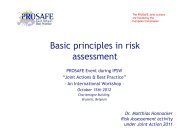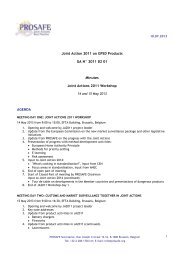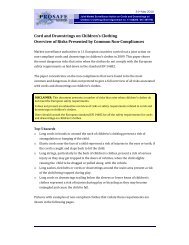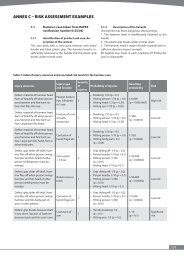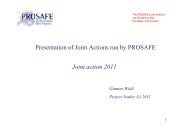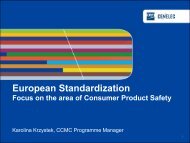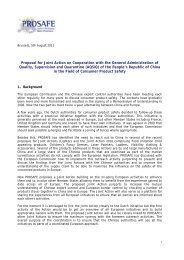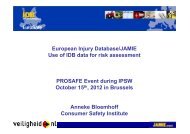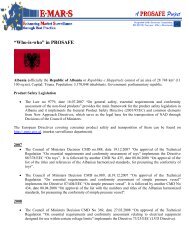Canadian Consumer Product Safety - Risk Assessment - Prosafe
Canadian Consumer Product Safety - Risk Assessment - Prosafe
Canadian Consumer Product Safety - Risk Assessment - Prosafe
You also want an ePaper? Increase the reach of your titles
YUMPU automatically turns print PDFs into web optimized ePapers that Google loves.
<strong>Canadian</strong> <strong>Consumer</strong> <strong>Product</strong><br />
<strong>Safety</strong> - <strong>Risk</strong> <strong>Assessment</strong><br />
Helen Ryan<br />
Director <strong>Risk</strong> <strong>Assessment</strong> Bureau<br />
<strong>Consumer</strong> <strong>Product</strong> <strong>Safety</strong> Directorate<br />
Health Canada
<strong>Consumer</strong> <strong>Product</strong> <strong>Safety</strong> Program<br />
New organizational structure established in<br />
January 2011 to support new legislation.<br />
Moved to functional model based on<br />
requirements of new Act.<br />
•<strong>Risk</strong> <strong>Assessment</strong> Bureau<br />
• Surveillance & Information Division<br />
• <strong>Product</strong> <strong>Safety</strong> Lab<br />
• <strong>Risk</strong> <strong>Assessment</strong> Division<br />
•<strong>Risk</strong> Management Bureau<br />
• <strong>Risk</strong> Management Strategies<br />
Division<br />
• Compliance & Enforcement<br />
Division<br />
• Standards Development Unit<br />
• Program Development Bureau<br />
• External Relations Division<br />
• Policy, Legislative and Regulatory<br />
Affairs Division<br />
• International and<br />
Intergovernmental Affairs Division<br />
Triage / Surveillance<br />
<strong>Risk</strong> Communication<br />
Policy<br />
International / IGA<br />
<strong>Risk</strong> <strong>Assessment</strong><br />
<strong>Risk</strong> Management<br />
2
Voluntary Reports<br />
Receiving Information under CCPSA<br />
• Received from consumers, Coroners, Medical Professionals, etc<br />
Mandatory Incident Reports<br />
• Mandatory Reporting is the requirement for Industry to report any incident<br />
related to a consumer product they supply as outlined in Section 14 of the<br />
CCPSA: Duties in the Event of an Incident. Intent of Section 14:<br />
– Provide better intelligence on the use of consumer products and the<br />
potential risks with respect to human health or safety, enabling early<br />
and proactive response to emerging hazards / trends; and<br />
– Respond where appropriate to consumer product health and safety<br />
incidents.<br />
Surveillance and Data Monitoring<br />
• Analyze reports and data from other sources<br />
– Look for trends in reports received by industry and consumers<br />
– Analyze incidents by type of product/country of origin<br />
– Analyze injury by age range/treatment/type of product<br />
3
Assessing <strong>Risk</strong> under the CCPSA<br />
What it is<br />
• Defining and taking a consistent approach to priority setting and making<br />
decisions about risk; developing clear processes for estimating the<br />
level of risk to the <strong>Canadian</strong> public posed by a consumer product<br />
<strong>Risk</strong> <strong>Assessment</strong> under the CCPSA<br />
• CPSD receives new information on a daily basis through incident and<br />
voluntary reports; surveillance activities<br />
• General prohibition will drive many of the risk assessments<br />
• Scope of products covered is broader (all products, including regulated<br />
products, covered unless specifically exempted)<br />
• Need consistent, risk-based approach to prioritize work<br />
4
Triage<br />
6
<strong>Risk</strong> <strong>Assessment</strong><br />
7
<strong>Risk</strong> <strong>Assessment</strong><br />
• First Step - RA Level 1 <strong>Assessment</strong>:<br />
• Review and preliminary evaluation of the reported information<br />
available to date<br />
• Goal to complete within approximately 1 week after assignment to<br />
an officer<br />
• RA Level 1 Findings/Recommendations (select one):<br />
– Proceed to Further <strong>Assessment</strong>;<br />
– Assign to <strong>Risk</strong> Management;<br />
– Add to Surveillance ‘Watchlist’;<br />
– RA Case Complete, and advise as applicable.<br />
8
<strong>Risk</strong> <strong>Assessment</strong><br />
‘Proceed to Further <strong>Assessment</strong>’: RA Level 2 <strong>Assessment</strong><br />
• More detailed review and assessment of risk<br />
• Options for RA Level 2 <strong>Assessment</strong>:<br />
• Regional Offices communicate with industry/company;<br />
• Industry/company to supply further information and/or perform<br />
product testing;<br />
• Health Canada <strong>Product</strong> <strong>Safety</strong> Laboratory testing (when<br />
appropriate/necessary):<br />
– <strong>Product</strong> samples obtained from company<br />
– Development of Test Methods:<br />
• Relevant to the specific hazard<br />
• Related to analogous product Standards, when appropriate<br />
• Based on scientific research<br />
9
What it is<br />
Managing <strong>Risk</strong> under the CCPSA<br />
• Taking a risk-based approach to managing dangers to human<br />
health or safety posed by consumer products<br />
<strong>Risk</strong> Management under the CCPSA<br />
• New enforcement powers: orders, prosecution, administrative<br />
monetary penalty system (AMPS) where appropriate<br />
• Standards development / regulation and policy-making with<br />
broader mandate; General Prohibition<br />
• Conduct inspections in response to incident reports<br />
• Compliance, enforcement and education activities that predate<br />
the Act, such as regular market surveys for regulated<br />
products, compliance promotion, etc.<br />
10
<strong>Risk</strong> Management Options for CP Issues<br />
CPS has variety of options for addressing issue in<br />
immediate and longer term, including:<br />
• Short-term<br />
- Removal of product from market<br />
• sale and distribution<br />
• quarantine, correction (if possible), disposal<br />
- As necessary, information to consumers<br />
• advisory, recall<br />
• Long-term<br />
- Additional compliance and enforcement options with the company<br />
– to address current and future non-compliance<br />
- Standards, regulations, or other measures depending on the<br />
circumstance and issue<br />
– as guidance or voluntary requirement<br />
– as regulatory (mandatory) requirements<br />
- Public education<br />
– appropriate where consumers need guidance on safe selection<br />
and use of consumer products<br />
11
<strong>Risk</strong> <strong>Assessment</strong> Case Study – Cadmium in Children’s Jewelry<br />
12
Cadmium in Children's Jewelry – Assessing the <strong>Risk</strong><br />
• Cyclical enforcement in 2009/2010 revealed high levels of<br />
lead and cadmium in children’s jewellery (up to 93% total<br />
cadmium concentration)<br />
• Concern that some manufacturers may be switching<br />
from lead to cadmium as a source of inexpensive metal<br />
• Advisories posted January 15 and May 17, 2010<br />
• October 19, 2010, Health Canada calls on industry to<br />
voluntarily stop production, importation and sale of<br />
children's jewellery made with the intentional use of<br />
cadmium or cadmium-containing materials
Guideline for Cadmium in Children’s<br />
Jewellery<br />
• July 25, 2011, draft guideline for consultation proposes<br />
limits for total cadmium in children’s jewellery to 130 ppm<br />
0.9516 mg (pMRL - < 4 yrs) = 130 ppm (0.013 %)<br />
0.0073 kg (95 th percentile weight)<br />
• Level set to protect small children from the risk of acute<br />
toxicity following ingestion, and of chronic toxicity from daily<br />
mouthing of jewellery.
Cadmium in Children's Jewelry – Managing the <strong>Risk</strong><br />
• Enforcement actions undertaken for levels above 130 ppm,<br />
will be taken under section 7(a) or 8(a) of the Canada<br />
<strong>Consumer</strong> <strong>Product</strong> <strong>Safety</strong> Act (CCPSA).<br />
• Health Canada is considering regulation to address the risk<br />
of cadmium exposure via children’s jewelry.<br />
• CPSD will continue market surveillance of children’s jewelry<br />
through Cyclical Enforcement.<br />
• XRF technology being used to verify compliance of metallic<br />
children’s jewelry.


